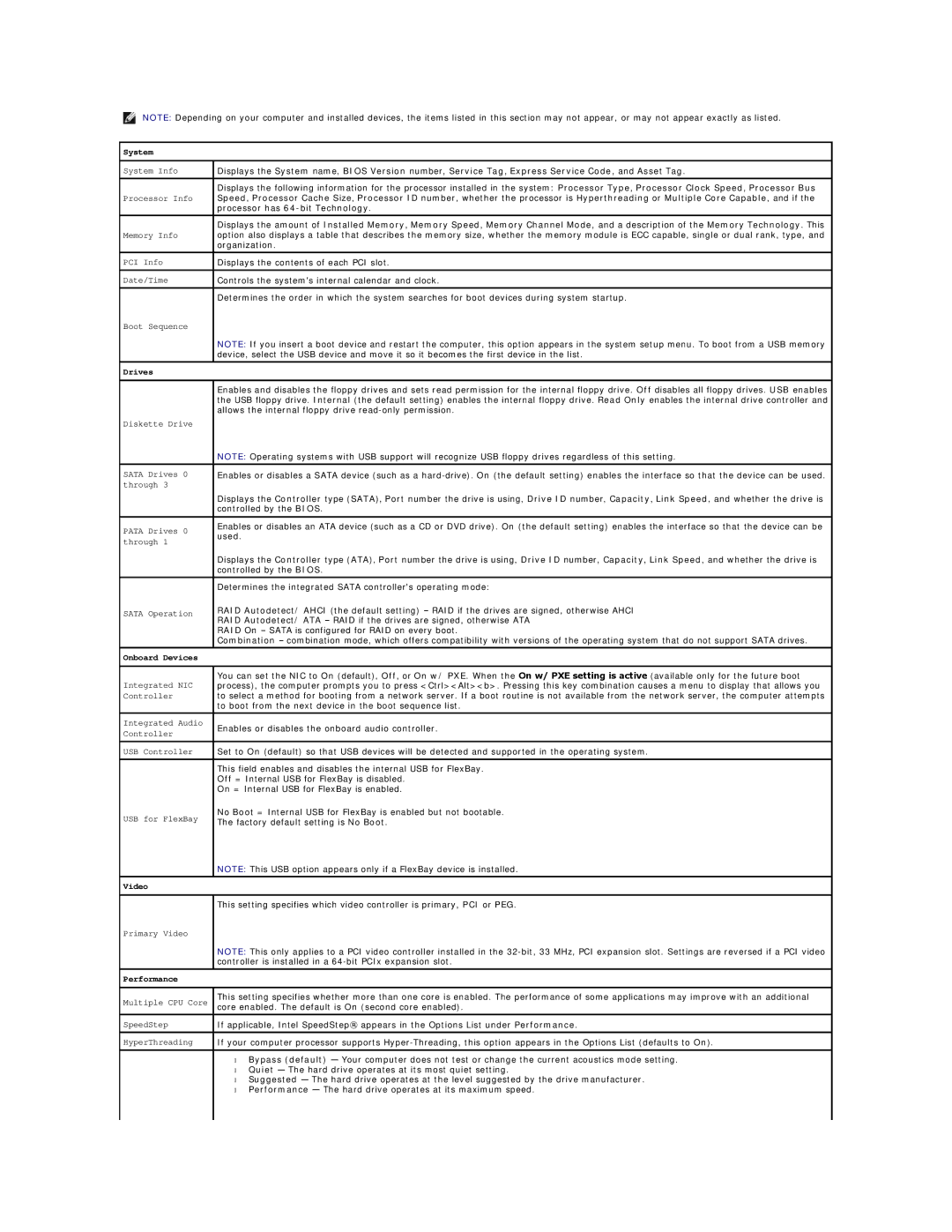
NOTE: Depending on your computer and installed devices, the items listed in this section may not appear, or may not appear exactly as listed.
System
System Info | Displays the System name, BIOS Version number, Service Tag, Express Service Code, and Asset Tag. | |
| Displays the following information for the processor installed in the system: Processor Type, Processor Clock Speed, Processor Bus | |
Processor Info | Speed, Processor Cache Size, Processor ID number, whether the processor is Hyperthreading or Multiple Core Capable, and if the | |
| processor has | |
| Displays the amount of Installed Memory, Memory Speed, Memory Channel Mode, and a description of the Memory Technology. This | |
Memory Info | option also displays a table that describes the memory size, whether the memory module is ECC capable, single or dual rank, type, and | |
| organization. | |
|
| |
PCI Info | Displays the contents of each PCI slot. | |
|
| |
Date/Time | Controls the system's internal calendar and clock. | |
|
| |
| Determines the order in which the system searches for boot devices during system startup. | |
Boot Sequence |
| |
| NOTE: If you insert a boot device and restart the computer, this option appears in the system setup menu. To boot from a USB memory | |
| device, select the USB device and move it so it becomes the first device in the list. | |
|
| |
Drives |
| |
|
| |
| Enables and disables the floppy drives and sets read permission for the internal floppy drive. Off disables all floppy drives. USB enables | |
| the USB floppy drive. Internal (the default setting) enables the internal floppy drive. Read Only enables the internal drive controller and | |
| allows the internal floppy drive | |
Diskette Drive |
| |
| NOTE: Operating systems with USB support will recognize USB floppy drives regardless of this setting. | |
|
| |
SATA Drives 0 | Enables or disables a SATA device (such as a | |
through 3 |
| |
| Displays the Controller type (SATA), Port number the drive is using, Drive ID number, Capacity, Link Speed, and whether the drive is | |
| controlled by the BIOS. | |
|
| |
PATA Drives 0 | Enables or disables an ATA device (such as a CD or DVD drive). On (the default setting) enables the interface so that the device can be | |
used. | ||
through 1 | ||
| ||
| Displays the Controller type (ATA), Port number the drive is using, Drive ID number, Capacity, Link Speed, and whether the drive is | |
| controlled by the BIOS. | |
|
| |
| Determines the integrated SATA controller's operating mode: | |
SATA Operation | RAID Autodetect/ AHCI (the default setting) – RAID if the drives are signed, otherwise AHCI | |
RAID Autodetect/ ATA – RAID if the drives are signed, otherwise ATA | ||
| ||
| RAID On – SATA is configured for RAID on every boot. | |
| Combination – combination mode, which offers compatibility with versions of the operating system that do not support SATA drives. | |
|
| |
Onboard Devices |
| |
|
| |
| You can set the NIC to On (default), Off, or On w/ PXE. When the On w/ PXE setting is active (available only for the future boot | |
Integrated NIC | process), the computer prompts you to press <Ctrl><Alt><b>. Pressing this key combination causes a menu to display that allows you | |
Controller | to select a method for booting from a network server. If a boot routine is not available from the network server, the computer attempts | |
| to boot from the next device in the boot sequence list. | |
|
| |
Integrated Audio | Enables or disables the onboard audio controller. | |
Controller | ||
| ||
|
| |
USB Controller | Set to On (default) so that USB devices will be detected and supported in the operating system. | |
|
| |
| This field enables and disables the internal USB for FlexBay. | |
| Off = Internal USB for FlexBay is disabled. | |
| On = Internal USB for FlexBay is enabled. | |
USB for FlexBay | No Boot = Internal USB for FlexBay is enabled but not bootable. | |
The factory default setting is No Boot. | ||
| NOTE: This USB option appears only if a FlexBay device is installed. | |
|
| |
Video |
| |
|
| |
| This setting specifies which video controller is primary, PCI or PEG. | |
Primary Video |
| |
| NOTE: This only applies to a PCI video controller installed in the | |
| controller is installed in a | |
|
| |
Performance |
| |
|
| |
Multiple CPU Core | This setting specifies whether more than one core is enabled. The performance of some applications may improve with an additional | |
core enabled. The default is On (second core enabled). | ||
|
| |
SpeedStep | If applicable, Intel SpeedStep® appears in the Options List under Performance. | |
|
| |
HyperThreading | If your computer processor supports | |
| • Bypass (default) — Your computer does not test or change the current acoustics mode setting. | |
| • Quiet — The hard drive operates at its most quiet setting. | |
| • Suggested — The hard drive operates at the level suggested by the drive manufacturer. | |
| • Performance — The hard drive operates at its maximum speed. | |
|
|
